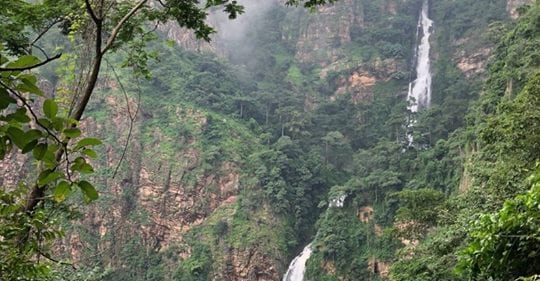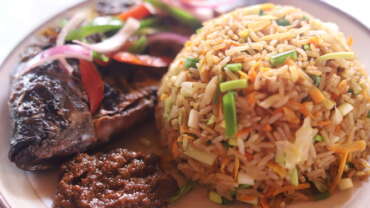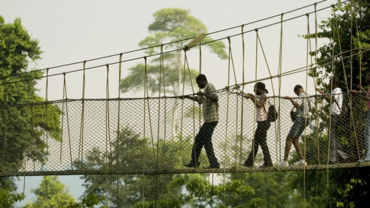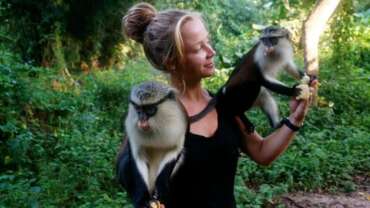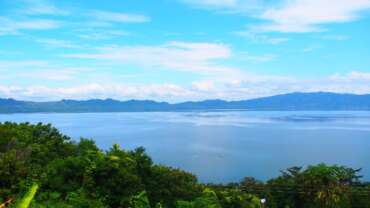Nature & Wildlife in Ghana
Nature is important to Ghana and a conservation program strives to protect this heritage, to enable us enjoy it with our visitors and to pass it on to future generations.
Ghana has a rich natural treasure made up of 16 National Parks, Resource Reserves and Wildlife Sanctuaries, which are open throughout the year.
From the savannah of the coastal plains, the dense tropical forest and the grassland of the north to the life giving water bodies, which criss-cross the country, distinct wildlife abound.
In the various reserves accommodation can be found.
ANKASA CONVERSATION AREA
Ankasa Conservation Area is twin Wildlife Protected Area comprising Nini-Suhien National Park and the Ankasa Resource Reserve. It is about 500km2 situated in the Western Region of Ghana.
Ankasa is the only area in the Wet Evergreen Forest Zoo. The Southwestern corner of the reserve is about 5 kilometres from the border town of Elubo. Takoradi is about 120 kilometres east.
Being the area with the highest rainfall in Ghana, Ankasa is the richest forest in terms of botanical diversity in the Country. Its natural resources are enough to announce its presence on the world tourism map as haven and Ghana’s tourism address therefore, there is no wonder that Ankasa remains as one of the natural treasures of the nation.
Its attractions include
Flora
Being the area with the highest in Ghana, Ankasa is the richest forest in terms of botanical diversity in the Country. About three hundred (300) plant species have been recorded in a single hectare. Notable among the plant is: Makore, Dahoma and Khaya. Ankasa is home to many well know plants including: Marantas, Glory bower, Bloody Lilly. There are also spectacular ferns and orchards.
Fauna
Charismatic and tourist-pulling animals such as the bongo and forest elephant as well as ten (10) primate species including the endangered Diana monkey and west African Chimpanzee abound in Ankasa. Bird fauna is also rich at least 263 bird species have been recorded so far.
The Water Fall
The Ankasa rainforest serves as shed for many steams and rivers. Three of them from which the forest derives its name are the Ankasa, Nini and Suhien. The fascinating characteristics of these rivers are the rapids found on them. The breezes along the rivers and rattling noise of the rapids are a delight to tourists. The potential canoeing is been explored.
The Bamboo Cathedral
The spectacular Bamboo Cathedral is located at Nkwanta about 8km from the Ankasa gate of the Park. Though not a church building and has no human Bishop, a priest nor a creed, the site showcases nature’s perfect architectural design. The giant and suppliant bamboos bow and criss-cross at their apex as if in a handshake to form a dome. The bamboos plants forming a canopy give the semblance of a cathedral over which the breeze presides a perfect habitation for relaxation.
Camping facilities
There are tourist camps here for those wishing to stay for a few nights in the park. The camping facilities are made mainly with local building materials are located at the Ankasa Gate, Elubo Gate and Nkwanta. These have floor space for sleeping; one can use hammocks. There are toilet and bath places as well as running water. Each facility also has fireplace and kitchen. A staff is close by the fruits abound around the area.
Access at all times from Accra through Takoradi on the Elubo highway by a 365km first class international road. From La Cote D’Ivoire the part can be reached through Osei Kojokrom and Dadieso.
ABURI BOTANICAL GARDENS
The Botanical Garden is century-old and offers a rich collection of tropical flora which attracts different birds and butterflies species. The tranquil paths serve as a walkway for the city dwellers after a hard days work. It is about one hour’s drive from Accra, the nation’s capital.
COASTAL WETLANDS RAMSAR SITES
The Ramsar sites are the relaxation and feeding grounds for over 70 water bird species. The birds flock in larger numbers; it is simply delight to watch. The sites also serve as the breeding grounds for about three marine turtle’s species. The ramsar sites include the Densu Delta Ramsar Site, the Sakumono Ramsar Site, and the Songor Ramsar Site.
DENSU DELTA RAMSAR SITE
This Ramsar site lies just West of Accra. The Densu River which feeds the wetland is about 116 km long, and it has an area of about 2,460 km2. The construction of the Weija dam in 1978, just 8 km inland from the Atlantic sea, reduced the effective catchment area of the Densu Delta Wetland to about 60.5 km south of the dam.
DIGYA NATIONAL PARK
Created in 1971 with an area of 3,478 sq. km, Digya is located on a lowland peninsula west of the central shores of the Volta Lake. The vegetation of the Park is largely savannah woodland and gallery forest along the riverbanks. Mammals include elephant, buffalo, water buck, hartebeest, bush pig, baboons and five other species of monkeys.
BIA NATIONAL PARK
Bia National Park is bordered to the south with a 563 square kilometer Resource Reserve and is an International Biosphere Reserve Park. The reserves are situated in the transition between the moist evergreen and semi-deciduous tropical forest and cover much of the drainage for the Bia river. Bia became a protected area in 1935 and an official national park in 1974. Some of the tallest trees left in West Africa are found in this park.
There are 62 species of mammals known to exist in the park including 10 primate species (three species of colobus, the Diana monkey and the chimpanzee, Pan troglodytes, among others), leopard, buffalo, the forest elephant, Loxodanta cyclotis, and the bongo, Tragelaphus euryceros.
Over 160 species of birds including hawks, eagles, bulbuls, flycathers, the black-collared lovebird and the threatened white-breasted guinea fowl live in this habitat. The park is the only known home of Agama sylvanus, a newly discovered species of lizard.
Bunso Arboretum
Bunso, just two hours from Accra, offers visitors a combination of semi-deciduous native forest and species introduced to Ghana by the Plant Genetic Resources Centre of Bunso, which uses the facility for research. The site contains over 110 species of birds, 30 species of butterflies and a herb garden with over 40 species. Tour the arboretum with a guide to learn about the native and exotic plants, including their medicinal properties for traditional healing, or go on an indigenous foods tour to learn the many ways in which local people harvest food from local plants. Guests can also experience village life and cocoa farming on a tour of the nearby village.
Wli Waterfalls
Wli Waterfalls (pronounced ‘vlee’), also called Agumatsa Falls, is a popular and dramatic tourist site near the village of Wli not far from the Togo border. Most tourist make the easy walk to the lower falls, which is mostly a flat trail but stunning and beautiful in setting, made even more dramatic by the presence of thousands of fruit bats nesting high up on the nearby cliffs. However, the equally high and much more isolated upper falls is a special treat for those with the stamina for the challenging hike. There are inviting pools at the base of both falls where the hearty can take a chilly dip.
The Wli waterfalls is the highest water fall in West Africa. The falls is known locally as Agumatsa waterfalls – meaning, “Allow Me to Flow.” It is located in the Hohoe municipality of the Volta Region, the land of the Ewe culture. It is approximately 280 kilometers from the capital Accra. The walk take you through the Agumatsa Wildlife Sanctuary, which features more than 200 bird species and 400 butterfly species.
Things to Do
- Hike with a tour guide to the lower falls on an easy, mostly flat trail that crosses two rivers 8 times on bridges.
- Branch from the main path with your guide to climb the steep and challenging trails to the upper falls. Sturdy footwear recommended.
- Visit the shrine of lesser gods, said to have been brought by village ancestors from Togo. Your guide will explain the history and other items of interest in the village.
- See the village ostrich farm, a new project with an NGO to create sustainable jobs with income from the sale of eggs. Your guide will show you the 25 animals on the farm and explain its operation.
Bobiri Forest and Butterfly Sanctuary
The Bobiri Forest and Butterfly Sanctuary is 54 square kilometres of virgin semi-deciduous tropical rainforest offering natural delights and one of the nicest ecotourism visitor centres and guesthouses in Ghana. See Bobiri’s massive trees, wide variety of birds, landscape butterfly garden (to showcase the sanctuary’s 400-plus butterfly species) and arboretum with plant labels. Each room of the guesthouse and visitor centre features a different mural painting created by a talented local artist.
Things to Do
- Enjoy the visitor centre’s comfortable chairs and shaded porch as you plan your hike and meet your guide. The centre also offers Ghanaian board games for relaxation and local drums to try.
- Take a guided nature walk which includes the sanctuary’s oldest tree (300-plus years) and its largest (it takes 24 people joining outstretched arms to encompass the tree).
- Tour the arboretum near the visitor centre either with a guide or on your own.
When to Visit
The forest is enjoyable anytime, but butterflies are most abundant March through June, with May being the peak most visible and active between 11 am – 4 pm on warm, sunny days. Sturdy shoes are recommended for hiking, as well as rain gear during the rainy season.
Wechiau Hippo Sanctuary and River Safari
Stretching along 40 km of the eastern bank of the Black Volta River, the Wechiau Hippopotamus Sanctuary is a protected area for hippos and associated species. It is home to one of only two remaining groups of hippopotamus in Ghana. Birdlife is also spectacular, with over 200 species on record. The river has had marked success in providing tourists with a unique and unusual eco-travel experience. Experience a river safari in a dugout canoe and see the resident hippo group, birds and mammals as well as fishermen plying their nets.



